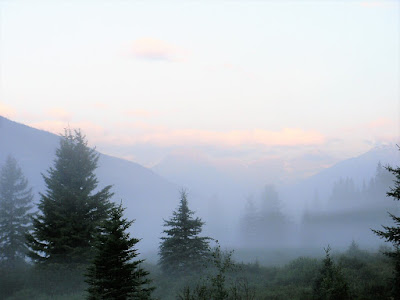 |
| All that's left |
They left two big gaps in the garden’s tree canopy that weren’t there before. It’s disconcerting seeing fresh wood chip mulch where evergreen branches used to sweep the ground.
Last week I finished planting new trees and shrubs in the newly opened spaces.
 |
| For now, small plants and lots of open space |
The hemlocks were native to eastern North America. I wanted to replace them with other plants from our region to offer food and habitat for native insects.
Between the vegetable bed and compost bins, two hemlocks used to stand along the side fence. I planted two conifers to replace the visual barrier the hemlocks provided. A northern white cedar, also called arborvitae (Thuja occidentalis ‘Smaragd’) will eventually grow 15 feet high and 6 feet wide.
 |
| Northern white cedar is native to our area |
A small white spruce (Picea glauca conica) went in nearby. This tree ranges across the northern reaches of the continent. You may know it as dwarf Alberta spruce, the little conical potted trees that are often sold as container plants or live Christmas trees.
 |
| This white spruce stays small because it's grown in a pot |
It starts small and grows slowly at first, but someday this spruce’s height may reach 10 feet.
The dense foliage of both these trees provide year-round shelter for birds and mammals. Birds eat the seeds and forage for insects among the branches.
In the same area, I added an American black elderberry (Sambucus canadensis). Doug Tallamy, the entomologist author of Bringing Nature Home, lists this small tree as highly desirable for providing native insects with nectar and leaves they’re adapted to eat. Birds will also enjoy its copious black fall fruits.
 |
| Elderberries |
In view of the vegetable bed, I planted a sweetshrub, also called Carolina allspice (Calycanthus floridus). Its distinctive dark red flowers are reputed to have an intoxicating sweet, fruity scent that attracts insects.
 |
| Sweetshrub has curious dark red flowers |
I also planted a mountain laurel (Kalmia latifolia 'Elf') with pink buds and white flowers. I love mountain laurel’s freckled blooms, and Tallamy lists this shrub too as a boon to native insects.
 |
| An older mountain laurel blooming in June |
In a back corner of the yard where three hemlocks used to grow, I put in two inkberries (Ilex glabra ‘Shamrock’). I’m hoping this bird- and insect-friendly native evergreeen will prove to be a tough, reliable substitute for nonnative boxwood (Buxus sempervirens).
 |
| Boxwood |
 |
| Inkberry |
Nearby in a spot visible from the kitchen window, I place a spicebush (Lindera benzoin), another of Tallamy’s choices that’s praised for its handsome yellow fall foliage.
 |
| Spicebush in fall--photo by tgpotterfield |
In case you’re wondering, I did find some of these young plants at the shop at the New England Wild Flower Society. This means they were grown without pesticides, so they definitely weren’t treated with neonics. I bought three at a sale at a local nursery. I can’t be sure those are neonic free. They don’t attract pollinators, though, so I hope they won’t sabotage the yard’s insect population.
I’m looking forward to finding out whether these natives will flourish. If they do, they’ll join an expanding list of plants that welcome a broad variety of insects and birds to the yard.
 |
| Native purple coneflower |






















